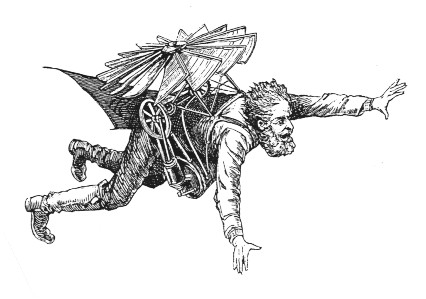Nineteenth-Century Transportation
Today, woodcuts shape the dream of 20th-century travel. The University of Houston's College of Engineering presents this series about the machines that make our civilization run, and the people whose ingenuity created them.
My wife gave me an odd book the other day. It was a collection of old engravings about transportation. They came from 19th-century magazines like Harpers, The Illustrated London News, and Scientific American.
There were only about 20 professional engravers in America in 1838. A generation later, there were 400. Illustrated magazines took off with a rocket assist from improved presses and people hungry for news. It was 1890 before we could make good half-tone illustrations from photos. So, for a time, engravings fed image-hungry Americans.
Those pictures not only trace our fascination with images. They also trace a new hunger to move rapidly and freely about this vast country. Let's see what they show us.
We begin with horse and human-powered vehicles. They show a fascination with buoyancy and design. The gigs and hacks grow lighter and more inventive. One-horse shays mutate into experimental bicycles. We follow a great parade of penny-farthings, unicycles, passenger tricycles -- even a man inside a giant rolling wheel.
At century's end, tiny motors appear on bikes and trikes. First you think they're embryonic automobiles. But these machines are buoyant as air.
The first cars are another matter. They carry steam boilers. We control them with the same levers you see in locomotive cabs.
No, the bike is going another way. Bicycle makers craved the airy lightness of being. They were about to give us the airplane. So we turn to the part on flight.
Now fancy mixes with fact. Bicycle pedals drive propellers to steer balloons. Here's a weird man-powered helicopter with seven propellers. It never could've flown. But there's Otto Lilienthal's glider. It flew very well indeed.
We move on to ships. Here are submarines powered by steam and by man. There is a sinister gathering of ironclad Civil War gunboats. The new ocean steamers and warships loom tall. They still carry sail -- just in case.
These fine engravings weave in the drama that photos usually leave out. Our imagination races in the headlamp of a locomotive screaming through night snow in the mountains.
In a few years we would turn our dreams of travel into set realities -- into trains, planes, and automobiles. But now, for a moment, these old woodcuts show the naked formative dream in full rush -- about to change America utterly.
I'm John Lienhard, at the University of Houston, where we're interested in the way inventive minds work.
(Theme music)
Harter, J., Transportation: A Pictorial Archive from Nineteenth Century Sources. New York: Dover Publications, Inc., 1984.
Marzio, P.C. The Democratic Art: Pictures for a 19th-Century America. Boston: David R. Godine, Publisher, 1979.
Don Piercy, the executive director of the Museum of Printing History, Houston, provided additional information.
